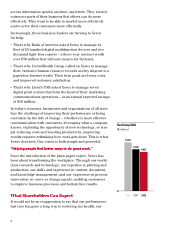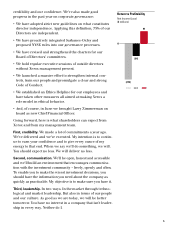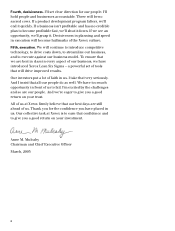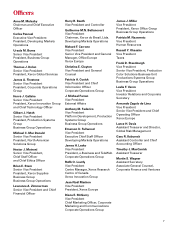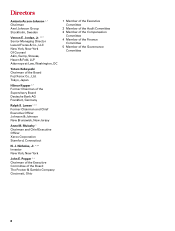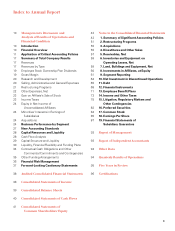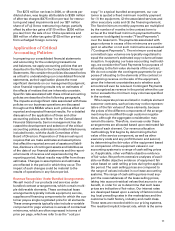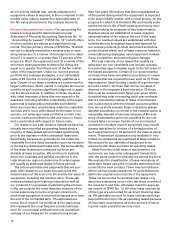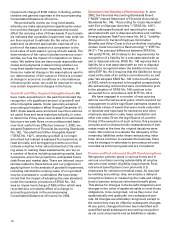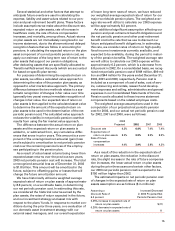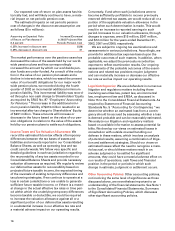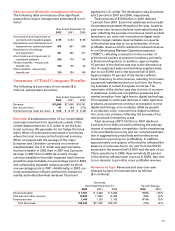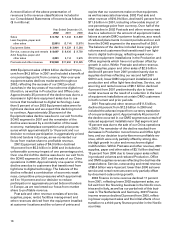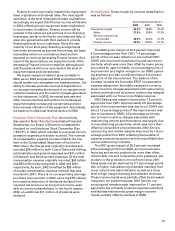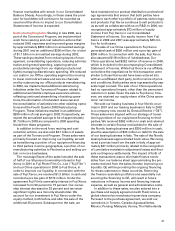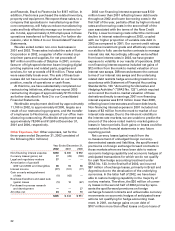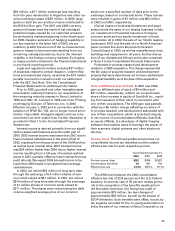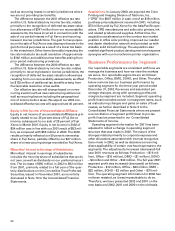Xerox 2002 Annual Report Download - page 16
Download and view the complete annual report
Please find page 16 of the 2002 Xerox annual report below. You can navigate through the pages in the report by either clicking on the pages listed below, or by using the keyword search tool below to find specific information within the annual report.
14
impairment charge of $106 million in Selling, admin-
istrative and general expenses in the accompanying
Consolidated Statement of Income.
We periodically review our long-lived assets,
whereby we make assumptions regarding the valua-
tion and the changes in circumstances that would
affect the carrying value of these assets. If such analy-
sis indicates that a possible impairment may exist, we
are then required to estimate the fair value of the
asset and, as deemed appropriate, expense all or a
portion of the asset, based on a comparison to the
book value of such asset or group of such assets. The
determination of fair value includes numerous uncer-
tainties, such as the impact of competition on future
value. We believe that we have made reasonable esti-
mates and judgments in determining whether our
long-lived assets have been impaired; however, if
there is a material change in the assumptions used in
our determination of fair values or if there is a materi-
al change in economic conditions or circumstances
influencing fair value, we could be required to recog-
nize certain impairment charges in the future.
Goodwill and Other Acquired Intangible Assets: We
have made acquisitions in the past that included the
recognition of a significant amount of goodwill and
other intangible assets. Under generally accepted
accounting principles in effect through December 31,
2001, these assets were amortized over their estimat-
ed useful lives and were tested periodically, in order
to determine if they were recoverable from estimated
future pre-tax cash flows on an undiscounted basis
over their useful lives. Effective January 1, 2002, we
adopted Statement of Financial Accounting Standards
No. 142, “Goodwill and Other Intangible Assets”
(“SFAS No. 142”), whereby goodwill is no longer
amortized but instead is assessed for impairment, at
least annually, and as triggering events occur that
indicate a decline in fair value below that of its carry-
ing value. In making these assessments, we rely on
a number of factors including operating results, busi-
ness plans, economic projections, anticipated future
cash flows and market data. There are inherent uncer-
tainties related to these factors and our judgment in
applying them to the analysis of goodwill impairment,
including risk that the carrying value of our goodwill
may be overstated or understated. We have deter-
mined that the impact of adopting this new standard,
under the transition provisions of SFAS No. 142,
was an impairment charge of $63 million which was
recorded as a cumulative effect of a change in
accounting principle in the accompanying
Consolidated Statement of Income for 2002.
Estimates Used Relating to Restructuring: In June
2002, the Financial Accounting Standards Board
(“FASB”) issued Statement of Financial Accounting
Standards No. 146, “Accounting for Costs Associated
with Exit or Disposal Activities” (“SFAS No. 146”),
which addresses financial and reporting for costs
associated with exit or disposal activities and nullifies
Emerging Issues Task Force Issue No. 94-3, “Liability
Recognition for Certain Employee Termination
Benefits and Other Costs to Exit an Activity (including
Certain Costs Incurred in a Restructuring)” (“EITF No.
94-3”). The principal difference between SFAS No.
146 and EITF No. 94-3 relates to the requirements for
recognition of a liability for a cost associated with an
exit or disposal activity. SFAS No. 146 requires that a
liability for a cost associated with an exit or disposal
activity be recognized when the liability is incurred,
while EITF No. 94-3 requires that the liability be recog-
nized at the date of an entity’s commitment to an exit
plan. We adopted SFAS No. 146 in the fourth quarter
of 2002, which is required to be applied prospectively.
All restructuring actions that were committed to prior
to the adoption of SFAS No. 146 continue to be
accounted for in accordance with EITF No. 94-3.
We have engaged in a number of restructuring
actions over the last several years, which required our
management to utilize significant estimates related to
realizable values of assets that were made redundant
or obsolete and expenses for severance and other
employee separation costs, lease cancellation and
other exit costs. Given the significance of, and the
timing of the execution of such actions, this process is
complex and involves periodic reassessments of esti-
mates made at the time the original decisions were
made. We continue to evaluate the adequacy of the
remaining liabilities under these restructuring initia-
tives. As we continue to evaluate the business, there
may be changes in estimates to amounts previously
recorded as actions progress and are completed.
Pension and Post-retirement Benefit Plan Assumptions:
We sponsor pension plans in various forms and in
various countries covering substantially all employ-
ees who meet certain eligibility requirements. Post-
retirement benefit plans cover primarily U.S.
employees for retirement medical costs. As required
by existing accounting rules, we employ a delayed
recognition feature in measuring the costs and obliga-
tions of pension and post-retirement benefit plans.
This allows for changes in the benefit obligations and
changes in the value of assets set aside to meet those
obligations, to be recognized, not as they occur, but
systematically and gradually over subsequent peri-
ods. All changes are ultimately recognized, except to
the extent they may be offset by subsequent changes.
At any point, changes that have been identified and
quantified await subsequent accounting recognition
as net cost components and as liabilities or assets.


